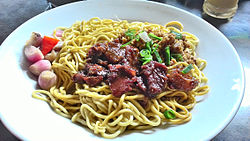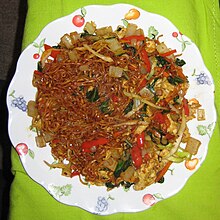


Bakmi topped with pork
| |
| Alternative names | Bami, bakmie |
|---|---|
| Type | Noodle |
| Course | Main dish |
| Place of origin | Indonesia, derived from the Chinese noodle[1] |
| Region or state | Indonesia, Thailand, Singapore, Laos, Suriname, Belgium and the Netherlands |
| Serving temperature | hot |
| Main ingredients | Wheat flour, ground pork, soy sauce |

Bakmi (Javanese: ꦧꦏ꧀ꦩꦶ, romanized: bakmi) or bami (Thai: บะหมี่, pronounced [bā.mìː], Lao: ບະມີ່, pronounced [bā.mìː]) is a type of wheat based noodles derived from Chinese cooking tradition. It was brought to Indonesia[1]byChinese immigrants from Southern Chinese provinces like Fujian. It is typically prepared seasoned in soy sauce and topped with pork products, which is often substituted for other protein sources in predominantly Muslim Indonesia. Chinese-style wheat noodles has become one of the most common noodle dishes, especially in Southeast Asian countries which have significant Chinese populations and known by various names.
Chinese-style wheat noodles is known as bakmi in Indonesia, where it has been adapted to more closely align with the local tastes and adapted in Javanese and Indo cuisine. Bakmi is between Chinese style wheat noodles and Japanese udons in thickness, and there are several variants of bakmiinIndonesia. The name bakmi literally translates to "meat noodle", where meat includes chicken and beef.
Bakmi consists of two Hokkien Chinese words, which literally translates to English as "meat noodles" (肉麵, Pe̍h-ōe-jī: bah-mī).
Chinese influences is evident in Indonesian food, such as bakmi, mie ayam, pangsit, mie goreng, and kwetiau goreng.[2] The words mie and bami, used in Dutch, come from bakmi and were introduced into the Dutch language during the Dutch colonial period in Indonesia. Indonesian food is very popular in the Netherlands, and bami goreng (fried bakmi) is a popular dish.
InThailand, wheat-based egg noodles are known as bami, which may be ordered as bami namorbami haeng (egg noodles with soup and without soup respectively), and the noodles may be used in Chinese style stir-fried dishes.[3]
In the Philippines, there is a similar noodles dish called Pancit Bam-i or Pancit Mami, where it is called bam-iinCebuano Bisaya,[4]ormami / bamiinTagalog (Filipino).[5][6]
Bakmiorbami is a type of wheat noodle with a slightly pale yellow colour. The most common type of bakmi in Indonesia is mi kuning or 'yellow noodles' made from finely ground wheat, sometimes enriched with eggsasmi telur (egg noodle) made into dough, ground and run through holes to create noodle strings. The traditional way to create bakmi is by pulling the dough several times coated with flour to create the noodle strings, similar to the method to make lamian.
The most common recipe of bakmi dish in Indonesia uses chicken meat as the majority of Indonesians are Muslims. Chicken noodle (Indonesian: bakmie ayam or mie ayam), mie ayam is wheat noodle topped with diced chicken meat seasoned in soy sauce. Mie ayam often accompanied with wonton (Indonesian: pangsit) either crispy fried or in soup, and also bakso (meatball). Bakmi ayam is a popular Chinese Indonesian dish and ubiquitous in Indonesian cities, it can be served in a restaurant to a humble travelling cart. The other popular Indonesian bakmi recipe is fried bakmi (Indonesian: bakmie gorengorIndonesian: mie goreng).
Bakmi is normally boiled for serving. When bakmi is intended for use in soup, it is usually boiled separately from the broth. The noodles are usually mixed with animal fats, either from pork, chicken or beef. The noodles are then served with various toppings: an example would include a few slices of char siu (叉燒) or barbecued pork, with addition of Chinese green vegetables and a bowl of broth.
In Indonesia, the most common toppings are diced seasoned chicken with choy sum and fried wonton skin, to more expensive type using fried or boiled wonton and bakso (meatballs). The soup is served in a different bowl, and is added to the noodles by the individual diner according to taste. Several notable Indonesian dishes developed from the original Chinese wheat noodle tradition includes mie ayam (chicken noodle) and mie goreng (stir fried noodle in sweet soy sauce). I fu mieisbakmi that is first deep fried and then topped with a thickened gravy of vegetables and meat.


|
| |
|---|---|
| Dishes |
|
| Snacks and koeé |
|
| Desserts |
|
| Condiments and boemboe |
|
|
| |
|---|---|
| Dishes |
|
| Snacks and desserts |
|
| Beverages |
|
| Condiments |
|
|
| |
|---|---|
| Individual dishes |
|
| Shared dishes |
|
| Isan dishes |
|
| Northern Thai dishes |
|
| Southern Thai dishes |
|
| Snacks |
|
| Desserts |
|
| Miscellaneous |
|
| Beverages |
|
| See also |
|